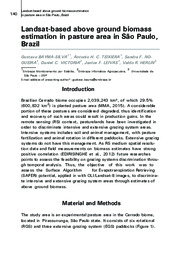Landsat-based above ground biomass estimation in pasture area in São Paulo, Brazil.
Landsat-based above ground biomass estimation in pasture area in São Paulo, Brazil.
Autoria: SILVA, G. B. S. da; TEIXEIRA, A. H. de C.; NOGUEIRA, S. F.; VICTORIA, D. de C.; LEIVAS, J. F.; HERLIN, V. R.
Resumo: Brazilian Cerrado biome occupies 2,039,243 km², of which 29.5% (600,832 km2) is planted pasture area (MMA, 2015). A considerable portion of these pastures are considered degraded, thus identification and recovery of such areas could result in production gains. In the remote sensing (RS) context, pasturelands have been investigated in order to discriminate intensive and extensive grazing system areas. Intensive systems includes soil and animal management, with pasture fertilization and animal rotation in different paddocks. Extensive grazing systems do not have this management. As RS medium spatial resolution data and field measurements on biomass estimates have strong positive correlation (EDIRISINGHE et al., 2012) future researches points to assess the feasibility on grazing systems discrimination through temporal analysis. Thus, the objective of this work was to assess the Surface Algorithm for Evapotranspiration Retrieving (SAFER) potential, applied in with OLI/Landsat-8 images, to discriminate intensive and extensive grazing system areas through estimates of above ground biomass.
Ano de publicação: 2016
Tipo de publicação: Artigo em anais e proceedings
Unidade: Embrapa Territorial
Palavras-chave: Aboveground biomass, Algoritmo SAFER, Biomass, Biomassa, Cerrado, Landsat, Pastagem, Remote sensing, SAFER, Sensoriamento remoto
Observações
1 - Por padrão são exibidas publicações dos últimos 20 anos. Para encontrar publicações mais antigas, configure o filtro ano de publicação, colocando o ano a partir do qual você deseja encontrar publicações. O filtro está na coluna da esquerda na busca acima.
2 - Para ler algumas publicações da Embrapa (apenas as que estão em formato ePub), é necessário ter, no celular ou computador, um desses softwares gratuitos. Sistemas Android: Google Play Livros; IOS: iBooks; Windows e Linux: software Calibre.
Acesse outras publicações
Acesse a Base de Dados da Pesquisa Agropecuária (BDPA) para consultar o acervo completo das bibliotecas da Embrapa.

